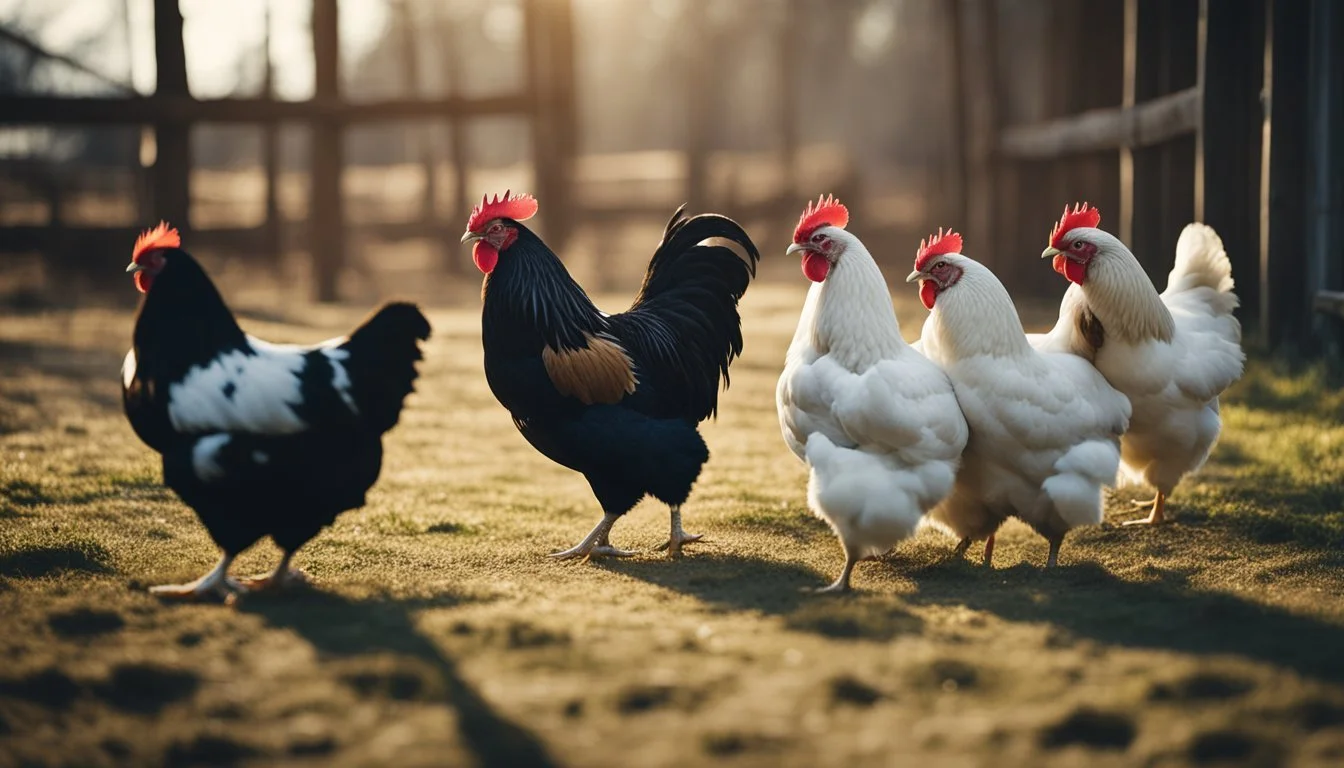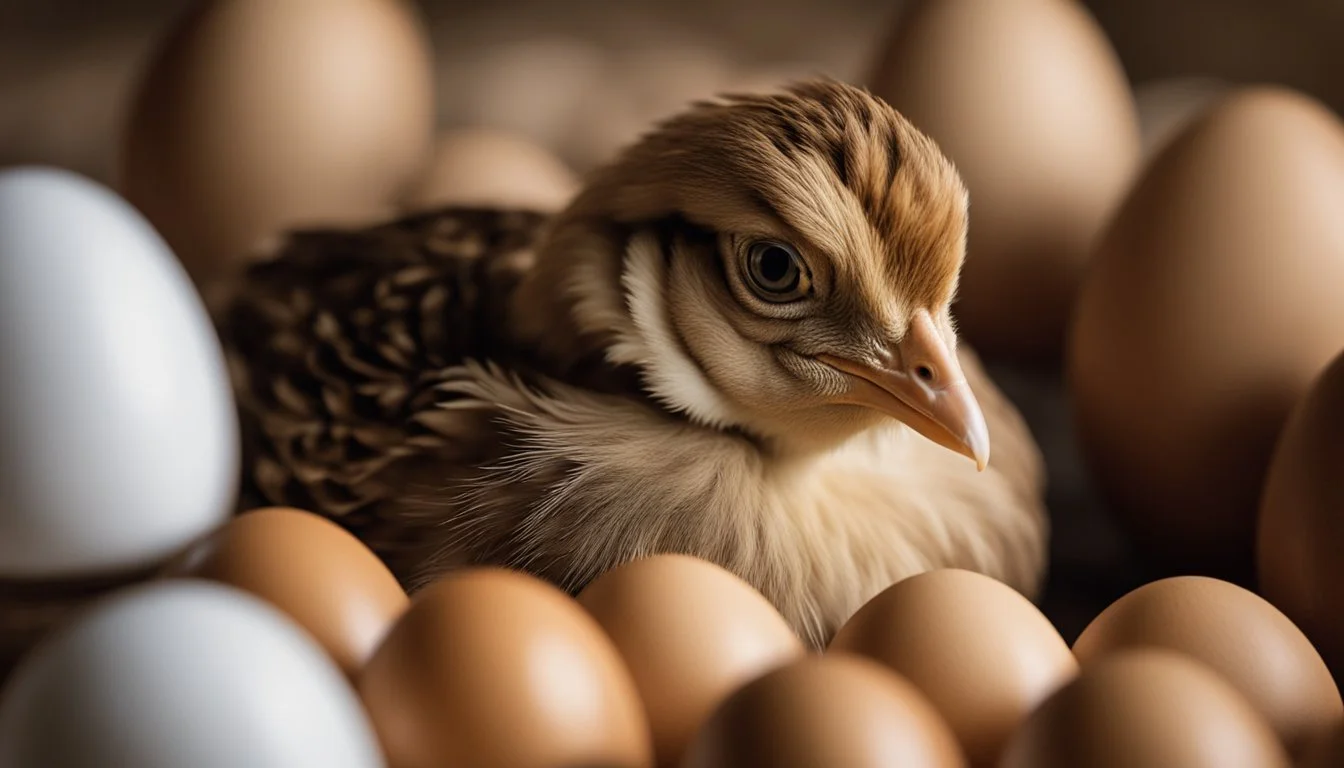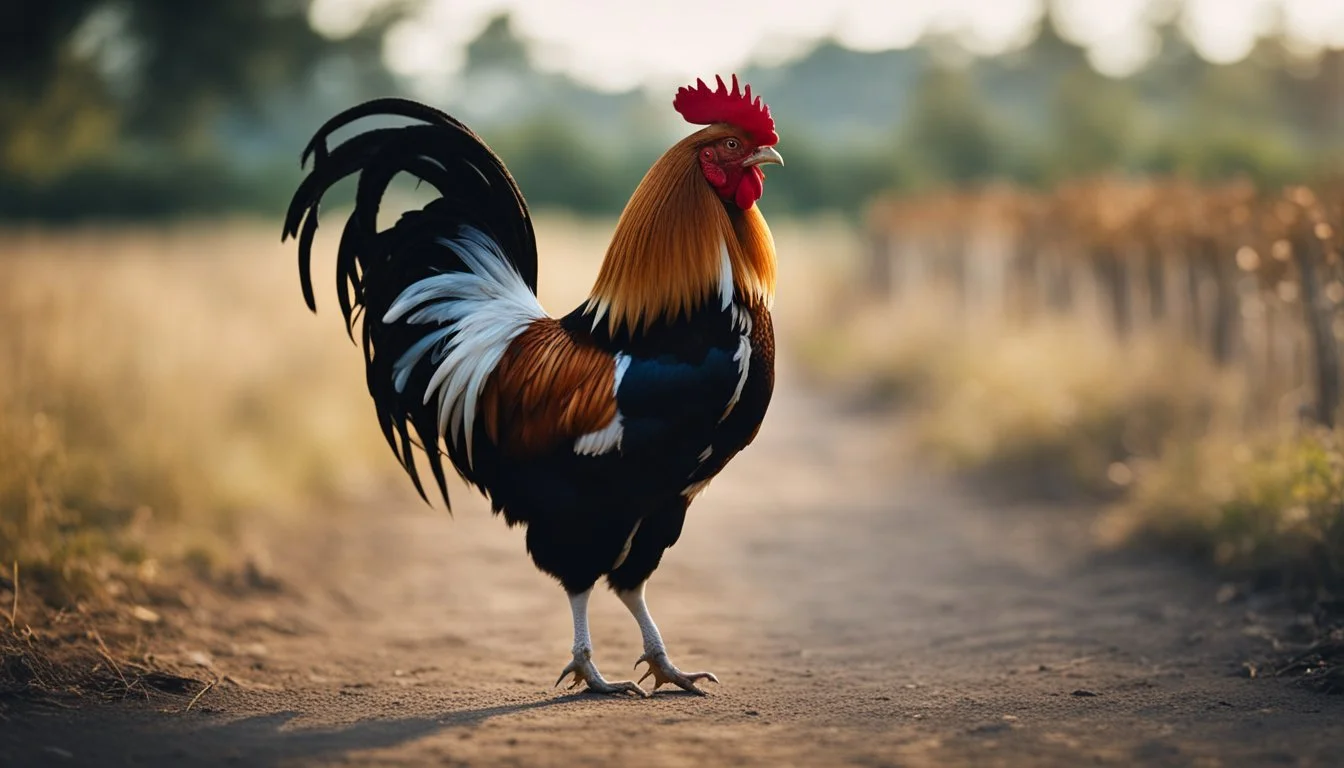8 Common Chicken Behaviors and What They Mean
A Quick Guide for Poultry Owners
Understanding chicken behavior is essential for any poultry keeper who wants to ensure the health and wellbeing of their flock. Chickens exhibit a range of behaviors that can indicate their physical and mental state, from dust bathing and preening to more complex social interactions like establishing a pecking order. Recognizing and interpreting these behaviors can help chicken keepers identify issues early and provide better care for their birds.
Chickens are fascinating creatures, with behavior patterns that reveal much about their needs and preferences. The more familiar one becomes with these behaviors, the easier it is to create a supportive environment for the flock. Whether it's the way chickens communicate through body language or how they engage in mating rituals, each behavior has a specific meaning and purpose within their social structure.
1) Nesting: When a Hen Sits on Her Eggs
When a hen is nesting, she stays on her eggs almost constantly. This behavior is most common in broody hens. They often refuse to leave the nest, not even for food or water, unless absolutely necessary.
A nesting hen tends to be more territorial. She might become aggressive if approached. This is a natural instinct to protect her eggs.
During this period, a hen might pluck her chest feathers. This creates a brood patch, allowing her body warmth to directly incubate the eggs. She will also turn the eggs periodically.
Sometimes a hen will sit on a nest even if there are no eggs. This can be a sign of broodiness. Remove such nesting materials to discourage this behavior if not desired.
Nesting hens can sometimes adopt eggs from other hens. This behavior ensures all eggs get equal care. Careful observation will confirm if this sharing of duties happens.
When nesting, maintain a peaceful environment. Disturbances can cause stress, leading the hen to abandon her nest. Always ensure food and water are within easy reach for the hen.
2) Preening: Cleaning and arranging feathers
Preening is an essential grooming behavior observed in chickens. This activity involves the bird running its feathers through its beak. Doing so helps to clean and maintain the feathers.
Chickens preen to ensure their feathers are aligned properly. Proper alignment aids in insulation and waterproofing, which are crucial for their well-being.
Preening also involves the use of a gland near the base of the tail. Chickens use the oil from this gland to coat their feathers. This oil adds a layer of protection, making the feathers more resilient.
Chickens usually preen when they feel safe and secure. It’s a vulnerable activity as they often close their eyes while preening. This indicates they do not perceive any immediate threat in their environment.
Excessive or insufficient preening can signal issues. Too much preening may indicate stress or parasites, while too little might suggest health problems. Regular observation of a chicken's preening habits can provide insights into their health and environment.
3) Dust Bathing: Rolling in dirt to clean feathers
Dust bathing is an essential behavior observed in chickens. It involves rolling or moving around in the dirt to maintain feather and skin health. The dirt helps remove parasites, dead skin, and excess oils, contributing to overall cleanliness.
Chickens engage in dust bathing not just for hygiene, but also for social interaction. It is common to see groups of chickens dust bathing together, indicating its role as a relaxing social activity.
The dust effectively coats the chicken’s feathers and skin, blocking the breathing pores of parasites and thereby suffocating them. This natural method of pest control is vital for their well-being.
In the absence of dirt, chickens may mimic the dust bathing motions, underscoring its importance in their behavioral repertoire. If possible, providing a designated dust bath area with materials like sand, wood ash, or diatomaceous earth can enhance their health and comfort.
4) Brooding: Sitting on Eggs to Incubate Them
Brooding is a natural behavior in chickens where a hen sits on her eggs to incubate them. This maternal instinct is driven by hormones and ensures the eggs are kept warm enough to develop into chicks.
A broody hen will sit on the nest for most of the day, leaving only briefly to eat, drink, and eliminate waste. She may become more protective and less social during this period.
Broodiness can occur even if the eggs are not fertile. Some chicken keepers use strategies like placing plastic eggs or golf balls in the nest to stimulate broodiness.
This behavior can be beneficial for those wishing to hatch chicks naturally. The hen takes care of maintaining the temperature and turning the eggs, which are crucial for successful hatching.
However, broody hens can also pose challenges. They might stop laying eggs and can be stubborn about leaving the nest. Some may even refuse to eat or drink enough, risking their health.
In such cases, it may be necessary to intervene. Techniques to discourage broodiness include regularly removing the hen from the nest and ensuring she has an active and engaging environment outside the coop.
5) Pecking: Common Sign of Establishing Pecking Order
Pecking is a fundamental behavior in chickens, crucial to their social structure. This behavior helps determine the hierarchy or the "pecking order" within a flock.
The pecking order establishes which birds have priority access to resources, such as food, water, and the best resting spots. Higher-ranking birds peck at lower-ranking ones to establish dominance.
Chickens often start exhibiting pecking behavior early in their life. Young chicks test social boundaries through playful pecks and small scuffles.
In addition to establishing hierarchy, pecking can also prevent conflicts later on. By having a clear social structure, tension and stress among the flock can be minimized.
Owners should be cautious when adding new birds to an existing flock. Introducing new chickens can disrupt the established hierarchy, leading to increased pecking and aggression temporarily.
6) Crowing: Rooster Signaling Territory
Roosters are known for their crowing, a behavior that serves several essential functions. One of the primary reasons roosters crow is to signal their territory. By crowing, a rooster announces his presence, asserting dominance and staking out the area for his flock.
This territorial crowing often happens before sunrise. The head rooster typically initiates the crowing, followed by subordinate males.
Crowing serves as a deterrent to other roosters, signaling that the territory is claimed. It helps maintain order within the flock, minimizing conflicts.
In addition to asserting dominance, crowing warns intruders and potential threats to stay away. This protective behavior ensures the safety and stability of the flock. By marking their territory audibly, roosters communicate their leadership and dedication to their role as protectors.
7) Roosting: Perching to Sleep at Night
Roosting is a natural behavior for chickens, where they seek elevated perches to sleep safely through the night. In the wild, chickens choose tree branches to roost, protecting themselves from ground predators. In a domestic setting, providing roosting bars or platforms replicates this instinct.
Chickens prefer to roost at heights of about 1.5 to 3 feet above the ground. The height can help them feel secure. Ensure roosting bars are accessible without causing chickens to bump their heads as they settle down for the night.
Each chicken needs approximately 8 to 10 inches of roosting space. This spacing helps prevent overcrowding and ensures each bird can rest comfortably. If bars are set high, ladders or ramps should be provided to help them reach their perch without strain.
Roosting behavior also allows chickens to maintain social hierarchies. Higher perches are often taken by more dominant birds. This behavior underscores the importance of providing adequate roosting options to prevent stress within the flock.
Observing roosting habits gives insight into the health and dynamics of your flock. Ensuring proper roosting conditions contributes to their overall well-being and comfort.
8) Foraging: Searching for food
Foraging is a fundamental behavior in chickens. It involves searching for food by pecking and scratching at the ground. This activity is deeply rooted in their natural instincts.
Even when provided with ample food, chickens will still forage. They prefer working for their food, a practice known as contra-freeloading. This instinct remains strong even in domestic settings.
Chickens' foraging includes pecking at potential food sources and sampling various options. This provides mental stimulation and physical activity, promoting overall health.
Free-range chickens experience more varied foraging behaviors. They have access to different types of food in open spaces. This variety can enhance both their diet and well-being.
Foraging is not just about finding food for nourishment. It also includes exploratory behaviors. Chickens use this time to interact with their environment.
In backyard settings, foraging is a common sight. It is enjoyable to watch as chickens energetically scratch and peck. Providing a diverse environment can help satisfy their foraging needs.
To support this behavior, offering a mix of grains scattered in the yard can be beneficial. This encourages natural foraging and keeps chickens active.
Understanding Chicken Communication
Chickens communicate using a variety of sounds and physical signals. Recognizing these forms of communication is key to understanding their needs and behaviors.
Vocalizations and Their Meanings
Chickens use specific vocalizations to convey different messages. Peeping is common among chicks to signal their location to the mother hen. When chicks are content, they often emit a happy trill, especially when finding food or nestling. In contrast, distress chirping occurs when they are uncomfortable or threatened, characterized by a loud and sharp sound. An even more urgent call is the panic peep, which is more insistent and penetrating, usually indicating immediate danger.
For adult chickens, clucking is frequent. They use it to communicate while laying eggs or notifying others about food. Crowing, mostly by roosters, signals dominance and territorial claims. Additionally, alarm calls are distinctive and sharp, warning about predators.
Body Language Signals
Chickens also use body language to communicate. Confident and healthy chickens exhibit an upright, perky posture and are often seen strutting around. They express contentment through preening and dust bathing. On the other hand, aggression is shown by raising feathers and holding wings out sideways, making them appear larger to intimidate threats or assert dominance.
When chickens squat, it often indicates submission or readiness to mate. A chicken spreading its wings and lowering its body can signal discomfort or submission as well. Noticing these cues helps in understanding and managing their social interactions and ensuring their well-being.
Social Structure and Behavior
Chickens exhibit complex social structures and behaviors crucial for their interactions and daily activities. Key aspects include their pecking order, which determines hierarchy, and their innate brooding and maternal instincts.
Pecking Order
The pecking order is fundamental to chicken social structure, defining each bird's ranking within the flock. This hierarchy influences access to food, roosting spots, and mating opportunities. Established through behaviors like pecking and posturing, dominant birds exhibit control and demand respect.
Observing these interactions reveals much about flock dynamics. Dominant chickens may engage in aggressive behaviors to maintain their status, while submissive ones show deference by moving away or avoiding confrontation. Understanding these dynamics helps in managing a peaceful and productive flock.
Brooding and Maternal Instincts
Brooding refers to a hen's instinct to sit on eggs to incubate them. This maternal behavior ensures the survival of the next generation. Hens exhibit specific behaviors like clucking softly, feather fluffing, and rarely leaving the nest.
Maternal instincts also extend to caring for chicks after they hatch. Hens lead their chicks to food, teach them to peck, and protect them from threats. This nurturing behavior fosters strong bonds and increases chick survival rates. Recognizing and accommodating these instincts is vital for healthy flock management.
Common Stress Indicators
Recognizing stress in chickens is crucial for maintaining their health and wellbeing. Two key stress indicators are feather pecking and behaviors like hiding and isolation.
Feather Pecking
Feather pecking is a behavior where chickens pluck out their own feathers or those of other chickens. This can be due to overcrowding, boredom, or dietary deficiencies.
In many cases, feather pecking starts as a minor issue but can escalate if not addressed. Chickens might develop bald patches or skin injuries.
Key Causes and Solutions:
Overcrowding: Ensure adequate space for each chicken.
Boredom: Provide environmental enrichments like perches and toys.
Diet: Ensure they have balanced feed with all necessary nutrients.
Careful observation and timely intervention can help mitigate feather pecking and maintain flock harmony.
Hiding and Isolation
Hiding and isolation are common behaviors observed in stressed chickens. A chicken that is frequently hiding or separating itself from the flock may be experiencing stress due to a predator threat, illness, or bullying from other chickens.
Common Triggers and Responses:
Predators: Secure the coop and run to deter potential threats.
Illness: Check for signs of illness and consult a vet if needed.
Bullying: Identify and separate the bully to reduce stress on the affected chicken.
By addressing these triggers, it is possible to reduce stress and encourage more natural, healthy behaviors.





